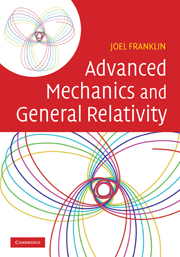5 - Scalar field theory
Published online by Cambridge University Press: 05 June 2012
Summary
The ultimate goal of the next two chapters is to connect Einstein's equation to relativistic field theory. The original motivation for this shift away from geometry, and toward the machinery of field theory, was (arguably) the difficulty of unifying the four forces of nature when one of these is not a force. There was a language for relativistic fields, and a way to think about quantization in the context of that language. If gravity was to be quantized in a manner similar to E&M, it needed a formulation more like E&M's.
We will begin by developing the Lagrangian description for simple scalar fields, this is a “continuum”-ization of Newton's second law, and leads immediately to the wave equation. Once we have the wave equation, appropriate to, for example, longitudinal density perturbations in a material, we can generalize to the wave equation of empty space, which, like materials, has a natural speed. This gives us the massless Klein–Gordon scalar field theory. We will explore some of the Lagrangian and Hamiltonian ideas applied to fields, and make the connection between these and natural continuum forms of familiar (point) classical mechanics. In the next chapter, we will extend to vector fields, discuss electricity and magnetism, and move on to develop the simplest second-rank symmetric tensor field theory. This is, almost uniquely, Einstein's general relativity, and the field of interest is the metric of a (pseudo-)Riemannian space-time.
- Type
- Chapter
- Information
- Advanced Mechanics and General Relativity , pp. 167 - 204Publisher: Cambridge University PressPrint publication year: 2010

